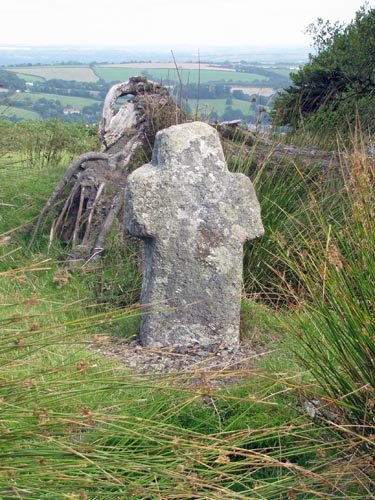 Location:
On the
brow of the hill and beside the road leading from Okehampton to the Army
Camp. Location:
On the
brow of the hill and beside the road leading from Okehampton to the Army
Camp.O/S Grid Ref: SX/59193/93786 Longitude/Latitude (Degrees+/-): -3.99635/50.72658 Map location: Click here to view map. Purpose: The cross may have served as a roadside cross to mark the route into Okehampton. However, folklore points to it being erected to mark the position of the nearby Fitz’s Well. Size: 2 feet 8 inches (0.81 metres) tall. 1 foot 7½ inches (0.50 metres) across the arms. The shaft is 13½ inches (0.34 metres) wide by 9½ inches (0.24 metres) deep. The incised cross measures 8 inches (0.20 metres) high by 5½ inches (0.14 metres) across the arms. Information: Tradition has it that the cross was erected by a man, after he and his wife had been ‘pixie-led’ and were lost in the fog on the moor. Eventually they ended up in this spot and were able to drink from the well, which immediately broke the spell and the fog lifted thus enabling them to continue on their way. The man is supposed to have erected the cross as a thanksgiving and in order to make it easier for others in need to find the well. However, it is more likely to have been erected by Sir John Fitz, after whom this and the other Fice’s Well, on the Blackbrook at Merrivale, is named. Sir John was a lawyer at Tavistock in the 16th Century and a similar story to that above has been told about him and the Merrivale well. The shaft of this cross has obviously been broken off at some stage and the cross is quite a bit shorter as a consequence. There is a worn, but visible incised cross in the centre on one side. It has been suggested that the cross originally stood at St. Michael’s Chapel at Halstock, about ¼ of a mile away. When the chapel fell into disrepair, in the 15th or 16th Century, the cross was brought over and erected in it’s present position. This would be about the time that Sir John Fitz was living at Tavistock and was also Lord of the Manor of Meldon and the owner of Okehampton Park.
Fitz’s Well is situated right next to the cross. Unfortunately, it’s not possible to see anything of the well as it has a concrete surround and is capped by a metal lid. There are also two stone slabs running along each side of the well, almost flat with the ground. Another 5 large stones have been laid across the slabs to cover it all completely. I presume this has been done for safety reasons. |